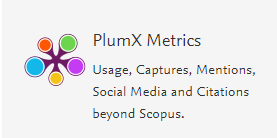There are many types of altmetrics. Some provide a count of document views or downloads, others provide ‘citation like’ metrics and some databases aggregate altmetrics to offer graphical representations of attention or mentions. Examples of these are aggregations are the PlumX Metrics ‘splat’ and the Altmetrics ‘donut’.
| PlumX Metrics 'splat' | Altmetrics 'donut' |
 |
 |
These are graphical representations of altmetrics for the article by VUW researcher, Carolyn E. Wilshire and others, “Rethinking the treatment of chronic fatigue syndrome – a reanalysis and evaluation of findings from a recent major trial of graded exercise and CBT” BMC Psychology, 6(1), Dec 2018. https://doi.org/10.1186/s40359-018-0218-3
Many Internet sites that host publications, such as publisher web sites and repositories, provide a raw count of the number of times a document is viewed or downloaded. These counts can be higher – and accumulate more quickly - than the number of citations a publication receives.
Examples:
For articles indexed in the Scopus database, the altmetric PlumX Metrics (aka ‘the splat’ graphic), provides information about citations, usage (including views) and captures. PlumX Metrics is also used in the pre-print service SSRN, owned by Elsevier.
In SciVal, a researchers’ Scopus profile can be imported and analysed. The Overview module offers the following metrics for an individual researcher: views count, outputs in top views percentiles, views per publication and field-weighted views impact. These relate only to Scopus indexed publications but provide a weighted metric rather than a straight count.
A ‘mention’ is an instance of attention that is tracked on the Internet. For this to occur research outputs need to have an associated DOI and that DOI needs to be included in the text of the communication.
Open access publishing allows direct access to research via a hyperlinked DOI. Mentions can occur in social media such as twitter and facebook, news media or policy documents. When collated, the source of the mention or a discussion about research may be graphically presented as the ‘splat’ (PlumX) or ‘donut’ (Altmetrics).
Open access publishing allows direct access to research via a hyperlinked DOI.
Examples:
A measure of the number of times a document is saved or captured by researchers into the large searchable bibliographic site Mendeley (Elsevier).
Examples:
